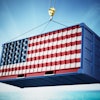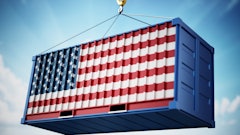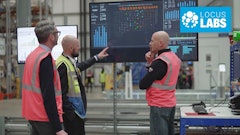
The July Logistics Manager’s Index reads in at 59.2, down (-1.5) from June’s reading of 60.7, and very close to May’s reading of 59.4. The movement back above 60 marks only the third time since July 2022, according to a report released by Arizona State University, Colorado State University, Florida Atlantic University, Rutgers University, the University of Nevada, Reno, and Council of Supply Chain Management Professionals (CSCMP).
The increase in the overall slowdown in expansion is driven by a decreased rate of expansion for inventory costs, which are down (-9.0) to 71.9. While this is notably slower than June’s rate of expansion of 80.9, it still represents a significant rate of expansion. Cost growth has likely slowed due to the dip (-4.2) in the expansion of inventory levels, which came in at 55.2 in July. This led directly to warehousing capacity moving (+3.3) back into expansion territory at 51.1.
Key takeaways:
· Over the last three months, logistics expansion is being disproportionately driven by smaller firms, who reported an overall index of 62.1, which is statistically significantly higher than the 56.2 that was reported by larger respondents. This continued disparity is largely driven by higher inventories and tighter capacity for smaller firms. Many of these smaller firms represent the “middle-mile” of supply chains, sitting between ports and manufacturers upstream and retail customers downstream. They are largely distributors, wholesalers, and logistics service providers. Essentially, they are holding the high levels of inventory that were brought into the United States to avoid tariffs but have not been moved down to retailers yet.
· Uncertainty is still high as the tariff situation continues to be a fluid one. President Trump signed an order imposing new tariffs on 66 countries starting Aug. 8. As of the time of publication, tariffs stand at 15% for the EU, 25% for India and Mexico (with a new 90-day negotiating period for the latter), 35% for Canada, 30% for China, 50% on Brazil, and 15% for Japan and South Korea. There are also 40% tariffs on transshipments of Chinese goods passing through another country if they did not undergo “substantial transformation.
· Markets were down sharply on Aug. 1 as a result of the tariff announcements. The dip may have been somewhat tempered however by the weaker-than-expected job report. The United States added 73,000 jobs in July, which was lower than anticipated. The previous two job reports were also revised down significantly, with May being revised down 125,000 positions to 19,000 jobs added, and June being revised down 133,000 positions to 14,000 added. That means that over the last three months, an average of 35,300 jobs have been added.
· The GDP increased by 3% in Q2, a shift away from the 0.5% decline in Q1. Nearly all of this shift can be explained by trade dynamics. In Q2 the United States had a positive trade balance, partly due to the “air pocket” in May when tariffs were elevated. One of the most important aspects of this, particularly for firms in the logistics industry looking to make capital expenditures, is how it will impact interest rates.
· Inventory levels expanded more slowly (-4.2) in July at a rate of 55.6. This moderated rate of expansion hides significant differences in inventory strategies at the different levels of the supply chain. The most drastic of these is that smaller (<999 employees) respondents reported rapidly expanding inventories at 64.8, while larger (1,000-plus employees) reported mild contraction at 47.6.
· Much of the upstream inventory being held by smaller firms are recent imports. Shippers took advantage of the extension of the tariff pause. Pre-extension, yhe Port of LA had been expecting a drop of 27.2% year-over-year at the end of July but instead saw an increase of 35.2%, a 62.4% increase. This comes on the heels of the busiest June ever at the Port of LA, which processed 892,340 TEUs in the month. Interestingly, container volumes are expected to drop off again following the first week of August and the re-implementation of tariffs.
· Southeast Asian manufacturers also reported their lowest level of sentiment since the pandemic five years ago, citing a lack of demand for their goods.
· The warehousing space that firms have to hold these inventories continues to be tight, although there was some loosening (+3.3) in July as warehousing capacity went from slight contraction at 47.8 to mild expansion at 51.1. Warehousing capacity is much tighter for smaller respondents (45.3) than larger respondents (55.0), and for upstream respondents (48.6) than downstream respondents (52.4).
· A similar split exists for warehousing utilization. The overall metric slowed (-2.8) to 59.4. However, upstream firms that are tight on available capacity reported robust expansion at 62.0, which downstream firms that are keeping inventories low reported contraction in their utilization of available space at 47.6.
· Prices continue to expand, holding steady at 68.3 which is a robust rate of expansion. This is fairly consistent across the board, with no major differences existing between upstream and downstream, or small and large firms. At a national level, warehousing rents are up but the rate of change has softened. The average price for industrial space was up to $10.06 in Q2, only slightly up from the average of $9.99 in Q1 and $10.03 year-over-year.
· Transportation utilization was the most significant mover in July, with its rate of expansion increasing (+6.6) to 59.5. This was primarily driven by upstream firms, who reported robust expansion of 60.7, while downstream reported no change at 50. There was little change overall for transportation capacity (+0.2) as it came in at 52.6. This metric has now registered soft rates of expansion, with every reading over the last 12 months coming in between 50-55.2. So long as this metric comes in above 50, it is unlikely that there will be a robust expansion in the freight market.
· Transportation was one of the winners of the latest jobs report, as unadjusted for seasonality, truck transportation added just under 8,000 jobs in July. Air, water, and rail jobs essentially held steady over the same period.
· Future predictions expansion are lower for both inventory costs (-6.6 to 75.3) and warehousing prices (-0.8 to 74.7), although both are still quite high.




















